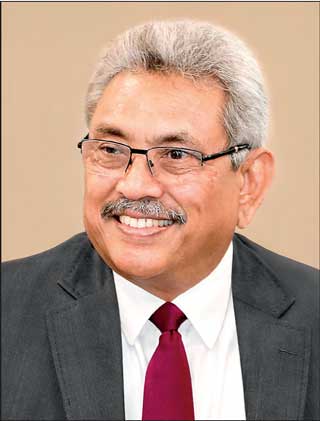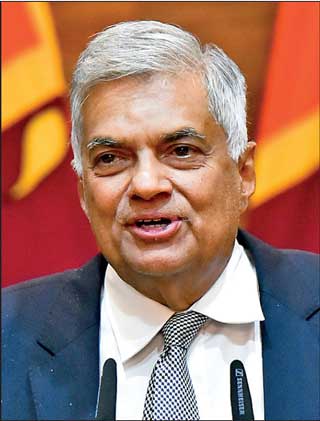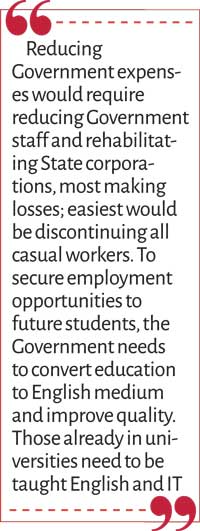Saturday Apr 19, 2025
Saturday Apr 19, 2025
Wednesday, 29 June 2022 00:10 - - {{hitsCtrl.values.hits}}
 |
| President Gotabaya Rajapaksa |
 |
| Prime Minister Ranil Wickremesinghe |
The country having gone through a heavy lockdown with the COVID pandemic is aiming for another lockdown, with Government offices closed on Fridays and two weeks work-from-home from 20 June. The decision was due to
non-availability of fuel for traveling to work. But private sector staff continue working.
The issues started with daily electricity power cuts since 22 February with fuel shortages caused by the foreign exchange crisis. The fuel shortage resulted in queues, which are becoming longer and longer, currently at the peak. In addition, cooking gas shortage led to another set of long queues. Even after price increases, the public are spending days in queues and there are occasional fights at fuel stations. The shortage of FE has affected imports; even medical supplies are running out.
How did this happen?
People blame President Gotabaya for the mess. True he did some blunders such as reversing taxes imposed on high income groups, heavily reducing State income. He may not have been aware that the increased taxes were imposed in agreement with IMF during the Yahapalanaya regime. Our governments since independence continued expenses over income except for two years, survived with loans. But the loans, also the loan interest, had to be paid, with more and more loans.
Gotabaya refused loans and FE reserves came down. Then came the COVID pandemic. Gotabaya, former Army Commander, may not understand economics, but he fought the pandemic as another war. With the Army’s help, Sri Lanka became among the first countries in the world to defeat the pandemic. But the country’s lockdowns reduced production and exports; meanwhile Government staff salaries remained intact, among few countries to continue. With shortage of funds to import chemical fertiliser for paddy cultivation, he suddenly announced moving over to organic fertiliser in April 2021, which resulted in crashing of paddy cultivation and farmers had no alternative but to protest. Today the Government has reversed organic farming, but chemical fertiliser is only a promise, expected in early July.
To prevent the public from starvation, the Government was forced to import rice mostly from India. It is claimed the Government spent more on importing rice than fertiliser imports.
 Poor advice to President
Poor advice to President
President Gotabaya was not alone in taking decisions. He was assisted by the Governors of Central Bank, Prof. W.D. Laksman, succeeded by Ajith Nivard Cabraal until Nandalal Weerasinghe took over in April 2022. P.B. Jayasundara was the Secretary to President until Gamini Senarath succeeded in January 2022.
Ajith Nivard Cabraal continued to print money for Government expenses and defended the Rupee/Dollar rate at Rs. 203 exhausting most of the Dollar reserves. Finally when the Dollar was liberated it reached almost Rs. 375, now settled to around Rs. 360, resulting in a Rupee depreciation by almost 75%, forcing the public to face rising food costs and other costs, without salary increases.
Without FE for imports the Government was forced to seek Indian assistance to import oil, gas and others. This year alone it obtained an Indian credit line of $ 500 million and another 200 million later, now all used up and expecting more.
Seeking help from IMF
Nandalal Weerasinghe took over Central Bank Governorship in April and immediately sought IMF help to overcome the crisis and attended IMF discussions in Washington along with former Finance Minister Ali Sabry. Sri Lanka is expected to show proposed steps to overcome the crisis, also ways to settle the loans expected from IMF, including existing loans.
At an online meeting with IMF, the PM agreed to improve local income over expenditure to 1% by 2025. This will require rehabilitation of a large number of State organisations and heavy staff reductions, would sure to create unrest.
For the second round, the IMF team is already here and discussions are taking place. The team would get first-hand knowledge of queues and public unrest. But funds from IMF will be possibly only around August. When IMF agrees, other countries too would look at Sri Lanka more favourably.
 Ending gas and fuel queues
Ending gas and fuel queues
The Prime Minister informed Parliament that with $ 80 million from World Bank and $ 20 m from the Treasury, 100,000 tons of gas would be imported next month and gas shortages would end.
Now, petrol prices have been revised to exceed Rs. 500. A car running 12 km from a litre will cost Rs. 40 a km for petrol alone. Most office staff will be forced to move over to bus travel. Three-wheel drivers have found selling petrol by staying in queue earns more than hires. This has resulted in petrol consumption coming down, shortening queues. Housewives will keep the filled gas cylinder in the kitchen, and cook with firewood.
Our politicians could set an example by using a smaller vehicle with a driver and a security guard without escort vehicles.
Renewable energy
The biggest foreign exchange expenditure is the import of oil for electricity generation, which could only be solved by replacing imported oil with renewable power generation using solar, wind, bio-energy and small hydro power, contract awards were suspended by CEB since January 2018.
Now that the Electricity Bill has been amended, Minister of Power and Energy Kanchana Wijesekera who had been concentrating on fuel supply, in a public discussion stated that plans for the electricity sector would be made public soon. The Minister who displayed his efficiency, the public expects him to handle CEB and take proper steps to resolve the issues.
First the 1,300 prospective investors capable of generating 4,000 MW of electricity registered and waited for over four years need be permitted to go ahead. But their proposals were based on former Rupee value and payable charges for generated electricity need be increased by 75%. But with increased loan interest rates by banks, some investors may not be willing to continue.
Immediate action
Installing roof-top solar would be the fastest way to reduce oil imports. Currently, CEB allows solar power generation only to the building’s maximum power consumption. The removal of restriction would allow large roofs of storage warehouses to be prioritised for solar installation. Also CEB’s unnecessary restrictions such as environmental approvals, joint inspections and many others, need to be removed. US Aid and Germany have already agreed to provide funds for import of solar panels. Thus, if the Minister initiates a proper plan, generating 1,000 MW from roof-tops within a year, reducing costly thermal power generation during daytime will not be difficult.
Country’s power requirement
The country started solar power plants in 2010 and wind power plants in 2012. With advancing technology solar prices came down in 2015, but CEB stopped RE project approvals in January 2018. Cost of electricity produced with solar is around Rs. 15-20, wind power around Rs. 12 for plants around 10 MW prior to devaluation. The country’s largest RE producer is the Mannar wind farm opened in December 2020, producing 103 MW costing $ 200 million. CEB engineers boasted that power produced cost only around Rs. 6 per unit. What cannot be understood is if the electricity produced is so low, why did not CEB continue with at least five more similar plants?
Currently coal power costs around Rs. 40 a unit, oil based power over Rs. 60 a unit, some plants reaching Rs. 120. Thus moving away from coal and oil to renewable energy is urgent for the country’s survival.
The country’s peak electricity demand is around 3,000 MW and is expected to reach 4,800 MW by 2030. Of the requirement large hydro produces 1,300 MW and 350 MW with private small hydro plants. Hydro production reduces with low rainfall and balance is managed with coal (900 MW) and oil powered plants.
The current coal and oil based electricity production amounts to 2,000 MW, but considering wavering nature of solar and wind, the country would need a capacity around 3,000 MW under RE and more in following years.
Considering the cost of Mannar wind power plant, a RE power plant would cost around $ 3 million per MW. Thus moving away from coal and oil will require around $ 9,000 million. The Government has requested only $ 4 billion from IMF; then how could the country find $ 9 billion? Thus help from every possible source is urgent.
 Visiting Indian team
Visiting Indian team
The Prime Minister informed the Parliament recently that India’s recent assistance amounts to $ 4 billion, whereas SL’s request from IMF too is $ 4 billion. The recently arrived four-member Indian team was expected to finalise another $ 1 billion credit line, for fuel and essential goods. The team has responded by saying it will consider.
MOU with Adani
Recently COPE Committee raised the signing of MOU with Indian company Adani for the generation of 500 MW of electricity with solar and wind power payable in dollars. The CEB Chairman’s behaviour forced him to leave his job; the entire process showed mishandling.
India came to our rescue during the most difficult period and is fair to make a request in return. If Indian PM Modi requested Gotabaya to award a contract to Adani, our Ambassador to India Milinda Moragoda could have discussed the matter with the Indian Energy Minister and signed an agreement nominating Adani as India’s representative. The Cabinet acceptance of agreement between the two countries make tender calling unnecessary.
Wind power in Tamil Nadu
Tamil Nadu just across Palk Strait, the Wind Power leader in India, produces wind power of 7,630 MW, 29% of India’s total. Tamil Nadu’s Muppandal wind-farm capacity 1500 MW is India’s largest.
North-western Sri Lanka especially Mannar region is blessed by the same wind stream, with a massive wind power generating capacity, well over the country’s requirement, needs making use early.
Sharing electricity with India
India imports/exports electricity between neighbouring countries and has issued the “Guidelines for Import/Export (Cross Border) of Electricity 2018”. Presently, India exports electricity to Nepal 700 MW, Bangladesh 1,160 MW and Myanmar 3 MW; also a high capacity link is under discussion. In addition, India imports around 2,000 MW of power from Bhutan.
India claims an interconnection between India and Sri Lanka is under discussion, but our politicians are ignorant. If we discuss and agree with India, the country will receive cheaper electricity around 500 MW within two years, reducing import of expensive oil.
Getting cheaper fuel and gas
Our sole refinery is 40 years old, and could only produce 25% of our needs; thus balance is imported. Meanwhile, one million ton capacity oil tanks in Trincomalee inherited from British idled for 75 years, were recently leased to India.
If we request India to install a large capacity crude oil refinery in Trincomalee as a joint venture, the excess capacity could be sent to India. They could purchase bulk crude oil when market prices are low and stockpile in available tanks. By the time refinery construction is complete in few years, the Russia-Ukraine war would have ended with lower oil prices.
IMF conditions for the loan
When SL requested funds from IMF, their conditions included rehabilitation of over 40 State organisations who have massively contributed to the current mess. But the organisations were not made public; even the ministers seem unaware of organisations coming under them.
Improving economy
Few years ago, foreign exchange earned through export of garments, tourism and receipt from locals employed abroad balanced the FE requirements. But today, after the COVID pandemic import Dollar prices have gone up, supported by the Russia-Ukraine war. Thus balancing imports is difficult. With better supply of fuel and gas long queues would disappear and tourism will recover. The depreciation of the rupee will make the country be more attractive to tourists. Re-emergence of tourism will improve dollar supply.
Garment exporters claim they could double the exports if sufficient workers are available. A positive side of the current crisis is increased cost of living will force idling girls at home towards employment in the garment sector.
Recently, the Daily FT front page highlighted the possibility of exporting chicken to Singapore if proper chicken feed is available, as import of Malaysian chicken has been banned due to bird flu in Malaysia and Sri Lanka is free from bird flu. Thus the Government needs to come up with incentives to investors to reduce unemployment and increase exports but soon.
Now powdered milk is a rare commodity, but packeted fresh milk is freely available in supermarkets, but at a higher price. In three to four years with the expansion of large cattle farms the country would become self-sufficient in milk products.
Light at the end of tunnel
Sajith Premadasa and JVP are boycotting Parliament sittings for a week claiming Ranil Wickremesinghe has failed to submit proper proposals for the country’s economic recovery. They seem to expect PM to correct blunders of 75 years within six weeks.
The country’s problems are longstanding. Mainly 1. Expenses over the income since independence. 2. Loading the State organisations with staff under political patronage. 3. State corporations making huge losses while their employees are getting paid heavily. 4. Sinhala-based education neglecting possibilities of future employment.
Sri Lanka expects a loan of $ 4 billion from IMF, the 17th loan. The country’s conditions are far worse and loan conditions too would be tougher, will address above, except the last. But unless the education issue is addressed, students in universities also in Advanced Level classes will have no future and will easily be pushed towards a revolution by JVP and other affiliated organisations.
The agreement with IMF will allow rescheduling existing foreign loans, also receive help from other countries. Already World Bank, ADB, some countries and organisations have helped below $ 100 million each.
Currently, agriculture has crashed without chemical fertiliser. The expected fertiliser in early July would be too late for Yala farmers, but they will still use. The Government is planning to import fertiliser for the Maha season. If they arrive by mid-September the farmers will cultivate every inch with paddy and highlands with corn; by next February the country would be self-sufficient in rice.
The biggest problem facing the country is the purchase of oil for electricity generation, which could only be solved by moving over to renewable energy. We would have achieved same long ago if not for the obstructions by CEB engineers, who were after commissions from private power producers. Meanwhile the politicians were dumb and deaf. When the current Government wished to amend the Electricity Act, the Opposition proposed RE projects under 10 MW be exempted from calling for tenders. If same was implemented anytime after January 2018 when CEB stopped all RE projects, the country would have been in a much safer position.
Reducing Government expenses would require reducing Government staff and rehabilitating State corporations, most making losses; easiest would be discontinuing all casual workers. To secure employment opportunities to future students, the Government needs to convert education to English medium and improve quality. Those already in universities need to be taught English and IT.
Most urgent is moving over to renewable energy eliminating oil imports for power generation. Each day’s delay will cost the country millions of dollars. Now the Electricity Act has been modified allowing negotiated contract awards, instead of calling tenders saving valuable time. First 1,300 investors waiting since 2018, next solar and wind power from Adani and the electricity transmission line from India. But the efficient running of the system will require upgrading power grids to accommodate new generating plants, while keeping a sharp eye on CEB who will wish to sabotage
Discover Kapruka, the leading online shopping platform in Sri Lanka, where you can conveniently send Gifts and Flowers to your loved ones for any event including Valentine ’s Day. Explore a wide range of popular Shopping Categories on Kapruka, including Toys, Groceries, Electronics, Birthday Cakes, Fruits, Chocolates, Flower Bouquets, Clothing, Watches, Lingerie, Gift Sets and Jewellery. Also if you’re interested in selling with Kapruka, Partner Central by Kapruka is the best solution to start with. Moreover, through Kapruka Global Shop, you can also enjoy the convenience of purchasing products from renowned platforms like Amazon and eBay and have them delivered to Sri Lanka.
Discover Kapruka, the leading online shopping platform in Sri Lanka, where you can conveniently send Gifts and Flowers to your loved ones for any event including Valentine ’s Day. Explore a wide range of popular Shopping Categories on Kapruka, including Toys, Groceries, Electronics, Birthday Cakes, Fruits, Chocolates, Flower Bouquets, Clothing, Watches, Lingerie, Gift Sets and Jewellery. Also if you’re interested in selling with Kapruka, Partner Central by Kapruka is the best solution to start with. Moreover, through Kapruka Global Shop, you can also enjoy the convenience of purchasing products from renowned platforms like Amazon and eBay and have them delivered to Sri Lanka.